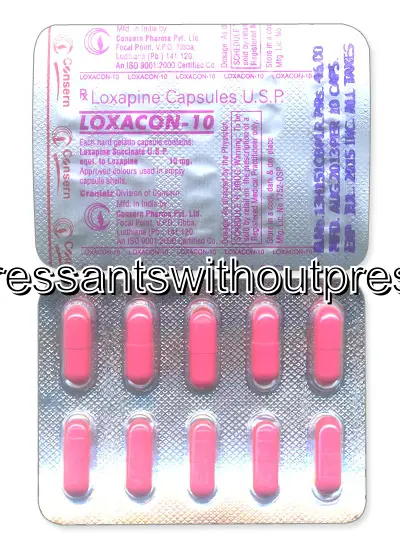| Package | Dosage | Price | Price per Dose | |
|---|---|---|---|---|
| Dosage: 10mg | ||||
| 360 pill | 10mg | €453.32 | €1.26 | |
| 180 pill | 10mg | €246.51 | €1.37 | |
| 120 pill | 10mg | €182.14 | €1.52 | |
| 90 pill | 10mg | €146.53 | €1.63 | |
| 60 pill | 10mg | €105.44 | €1.75 | |
| 30 pill | 10mg | €61.62 | €2.05 | |
| Dosage: 25mg | ||||
| 360 pill | 25mg | €646.43 | €1.79 | |
| 180 pill | 25mg | €362.93 | €2.01 | |
| 120 pill | 25mg | €273.90 | €2.29 | |
| 90 pill | 25mg | €223.23 | €2.48 | |
| 60 pill | 25mg | €162.97 | €2.71 | |
| 30 pill | 25mg | €95.86 | €3.19 | |

Loxapine Description
Introduction to Loxapine
Loxapine is a medication primarily used to treat schizophrenia and certain other mental health conditions. It belongs to the class of typical antipsychotics, which work by influencing the activity of neurotransmitters in the brain. This medication helps manage symptoms such as hallucinations, delusions, agitation, and disorganized thinking. Its effectiveness has made it a valuable option for patients who struggle with severe psychiatric disorders.
How Loxapine Works
Loxapine acts by blocking dopamine receptors in the brain, particularly the D2 receptors. Dopamine is a neurotransmitter involved in controlling mood, perception, and behavior. By inhibiting dopamine activity, loxapine reduces the positive symptoms of schizophrenia. Additionally, it has effects on other neurotransmitter systems, including serotonergic and adrenergic pathways, which contribute to its overall therapeutic profile. The result is a decrease in hallucinations, paranoia, and agitation.
Administration and Dosage
Loxapine is typically administered orally in the form of tablets, but it can also be given via inhalation in some cases. The dosage varies depending on the severity of the condition, patient response, and tolerability. Physicians usually start with a lower dose to minimize side effects and gradually increase it as needed. Patients should follow their healthcare provider’s instructions carefully and report any adverse reactions immediately. Regular monitoring is essential to ensure the medication's effectiveness and safety over time.
Potential Benefits of Loxapine
Many patients experience significant relief from their symptoms when taking loxapine. It can help stabilize mood, reduce hallucinations, and improve overall mental clarity. For some, it may also help reduce agitation and aggression associated with psychosis. The medication’s ability to quickly alleviate symptoms makes it a valuable tool in acute psychiatric settings. Its relatively rapid onset of action can improve patient comfort and facilitate treatment continuity.
Side Effects and Risks
Like all medications, loxapine carries potential side effects. Common issues include dry mouth, drowsiness, dizziness, and constipation. Some patients might experience weight gain or changes in blood sugar levels over time. More serious side effects, though less common, can involve extrapyramidal symptoms such as tremors or rigidity, and metabolic disturbances. Because of the risk of severe side effects like neuroleptic malignant syndrome or tardive dyskinesia, medical supervision is crucial. Patients should be monitored regularly for any signs of adverse reactions.
Precautions and Considerations
Loxapine should be used cautiously in individuals with pre-existing health conditions such as heart disease, liver issues, or a history of seizures. It may interact with other medications, including antidepressants, antihypertensives, and CNS depressants, so informing the healthcare provider of all current drugs is important. Pregnant or breastfeeding women should discuss potential risks with their doctor before starting treatment. Due to its sedative properties, operating machinery or driving should be avoided until the patient knows how loxapine affects them.
Conclusion
Overall, loxapine remains a valuable option for managing complex psychiatric conditions, especially when other treatments have not achieved desired results. Its ability to rapidly control symptoms can significantly enhance quality of life for many patients. Nonetheless, careful administration, regular monitoring, and attention to side effects are essential components of safe and effective treatment with this medication. Patients should always communicate openly with their healthcare provider to optimize outcomes and minimize risks.
